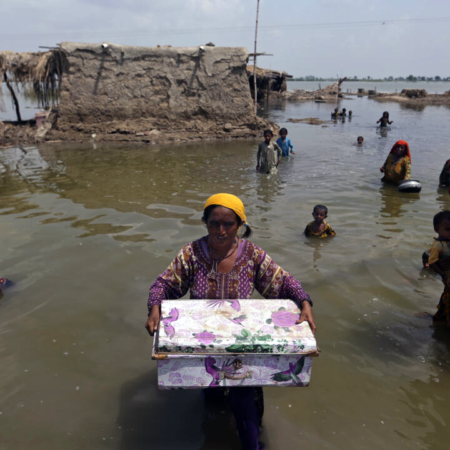
Gas Devi was born forty years ago, just after midnight, as toxic smoke plumes swept through the Indian city of Bhopal, where she was struggling to breathe.
The screams of men, women, and children as they fled the cloud of extremely deadly gas seeping from the Union Carbide factory on the evening of December 2, 1984, drowned out her weak cries.
Up to 25,000 people are thought to have perished total in the world’s biggest industrial accident, with about 3,500 people murdered in the immediate aftermath.
Devi and innumerable other people born with defects after that awful night are still plagued by the trauma forty years later.
Devi, a daily wage worker, frequently gets sick, has persistent chest pain, and one of her lungs is underdeveloped.
Speaking to AFP from her slum in Bhopal, the capital of the central state of Madhya Pradesh, Devi said, “My life is a living hell.” She can’t forget the night of her birth, even if she wanted to.
“My parents gave me the name Gas,” she added, tears in her eyes. “This name is a curse, in my opinion. I wish I had passed away that evening.

After one of the tanks holding the lethal chemical broke its concrete casing, 27 tonnes of methyl isocyanate (MIC), which is used to make insecticides, raced through the city of more than two million people. People began to collapse in the streets as the white cloud of MIC engulfed the vicinity of the factory.
The 81-year-old Nathuram Soni was one of the first to leave. The people’s mouths were frothing. Some were choking on their own vomit, while others had defecated,” Soni claimed.
Soni carried his crying neighbors, many of whom were babies, to the hospital on his pushcart while wearing a handkerchief knotted over his nose.
Persistent tragedy
Those who passed away were lucky, according to Rashida Bee, co-founder of the Chingari Trust charity, which provides free medical care to children from families afflicted by gas.
She remarked, “At least their suffering was over.” “Those who survived are the unfortunate.”
This year alone, more than 150 children with cerebral palsy, hearing and speech difficulties, and other disabilities were admitted to her charity. She attributes the problems to the groundwater poisoning and the accident.
Previous groundwater testing at the site found pollutants that cause birth defects and cancer 50 times higher than what the US Environmental Protection Agency considers safe.
Since the accident, Rashida, 68, has lost other family members to cancer. She stated, “This tragedy is showing no signs of relenting.” “Children are still being born with deformities because the soil and water here are contaminated.”
Campaigners claim that Union Carbide, which was purchased by the Dow Chemical Company of Michigan in 2001, frequently disposed of chemical waste in landfills years before the tragedy.
Thousands of liters of liquid waste were placed in large evaporation ponds outside the factory. The water and soil in a number of neighborhoods were contaminated. A request for comment from AFP was not answered by Dow Chemical.
48-year-old Tasleem Bano is certain that the plant is connected to congenital diseases. Mohammed Salman, her son, was born with his limbs spread wide.
In the womb, his twin brother passed away. She pointed to her son’s braces, which help him stand, and said, “Salman lived, but he was unable to speak until he was six years old.”

Tasleem, a young girl who lived near the factory and breathed in the fumes, stated, “Doctors say he is like this because of the gas.”
When asked his name, 12-year-old Salman could only reply with a toothy smile. Similar to Salman, hundreds of kids at the Chingari center have difficulty walking, talking, or eating.
“Corporate slaughter”
Gas survivors are waiting in line for treatment at the Sambhavna Trust facility nearby.
The founder of Sambhavna, Satinath Sarangi, stated, “Data very clearly shows that mortality in the exposed population compared to a matched controlled population is much higher.”
“When we surveyed our registered cohorts in 2011, we discovered that the mortality rate among those exposed to gas was 28% higher.” According to Sarangi, 70, a medical study has confirmed that the MIC fumes produced chromosomal abnormalities and weakened the immune systems of the impacted communities.
“Congenital malformations are far more common in children whose parents were exposed to gas.”
Union Carbide agreed to compensate the victims with $470 million in 1989 as part of a partial out-of-court settlement with the Indian government. However, the victims only earned $500 apiece and were not consulted throughout the discussions.
The present owners have declined to provide additional compensation for the tragedy that is still happening today.
Warren Anderson, the chairman and CEO of Union Carbide at the time of the tragedy, was accused of “culpable homicide not amounting to murder” in India in 1991. However, he was never put on trial. In 2014, Anderson passed away at the age of 92 at a Florida nursing home.
A case that is pending in court asks the government to pay 500,000 Indian rupees ($5,920) for each person who has been diagnosed with renal disease or cancer.
True justice still eludes the survivors, according to social activist Rachna Dhingra of the Bhopal Group for Information and Action.
She claimed that up until now, “not a single person has been imprisoned, even for a day, for killing over 25,000 people, injuring half a million, and contaminating the soil and groundwater.”
Because there is no legal system in place to hold these firms accountable globally, people in the city are still fighting.
“Corporations have learned how to get away with murder from Bhopal.”












No Comment! Be the first one.